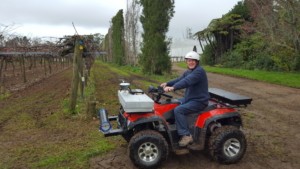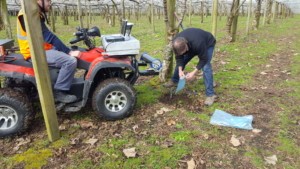
EIT researcher Chris Thorman on a quad bike in a kiwifruit orchard in Katikati with the GRS (gamma ray spectrometer) unit on the front.
EIT researchers are testing cutting-edge technology that it is hoped will significantly improve the economic and environmental outcomes of soil management for the agricultural and horticultural sectors.
The new technology measures natural background gamma rays which are given off by soils and converts that into detailed soil maps.
The system uses a Gamma Ray Spectrometer (GRS) mounted on an ATV and takes up to 800 data points every hectare as the vehicle is driven over the ground, measuring the background caesium, thorium, potassium and uranium radiation levels present in all soils. Three or four physical soil samples are taken to calibrate the readings for each block and the detailed soil maps are produced resulting in significantly improved soil analysis.
The scans produce maps for physical parameters, such as organic matter, sand, silt and clay percentages, carbon content, soil water holding capacity and plant available water as well as the nutrient values, such as potassium, phosphate, calcium, pH, magnesium, nitrate as N, boron, copper, iron, manganese, sulphur, sodium, and zinc.
The information can be fed into a precision-agriculture enabled tractor to allow variable rate applications so growers can target ”inputs” such as seed, fertilisers, water and lime to better meet the crop requirements, saving money, improving crop production and meeting the ever increasing environmental requirements.
The research is being conducted by Chris Thorman and Dr Glen Robertshaw, who lecture on the Environmental Management programmes at EIT’s School of Primary Industries. Chris, who is the project lead, and Glen, who is the technical lead, are conducting the research with industry support.
“If this system can be validated for New Zealand soil conditions it would give growers unparalleled detail of their soils and may help us understand how we can manage our growing operations to sustainably protect our soils while reducing the cost per tonne of produce,” says Chris.

EIT researcher Chris Thorman (right) takes soil samples for calibration at a kiwifruit in Katikati recently.
Glen says: “The potential for better environmental management of soils could be significant. It’s the old saying, if you can measure it you can manage it, and we hope this will be a practical and cost-effective management tool for the industry”.
Chris says that New Zealand’s international markets want to know “we are producing food in an environmentally sustainable way. Understanding and managing our soils is the first step in doing this.”
Over the next few weeks the GRS team will be working with the industry to test the technology and validate the systems to ensure it has value for growers across NZ.
Sponsors include Zespri, Vegetables Research & Innovation, Foundation for Arable Research, EIT Research and Innovation, FMG, Fruitometry, SoilOpix and Startafresh.
